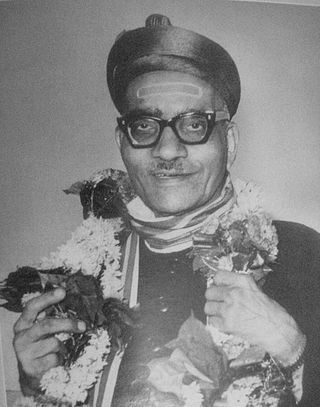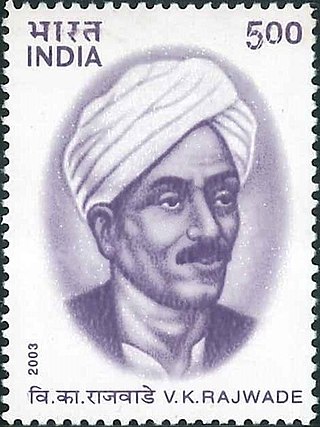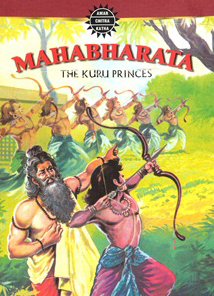
The Mahābhārata is one of the two major Smriti texts and Sanskrit epics of ancient India revered in Hinduism, the other being the Rāmāyaṇa. It narrates the events and aftermath of the Kurukshetra War, a war of succession between two groups of princely cousins, the Kauravas and the Pāṇḍavas.

Savitribai Phule Pune University (SPPU), formerly the University of Pune, is a public state university located in the city of Pune, India. It was established in 1949, and is spread over a 411 acres (1.66 km2) campus in the neighbourhood of Ganeshkhind. The university houses 46 academic departments. It has about 307 recognised research institutes and 612 affiliated colleges offering graduate and under-graduate courses. Savitribai Phule Pune University Ranked 12th NIRF Ranking in 2022

Pandurang Vaman Kane was an Indian academic, historian, lawyer, Indologist, and Sanskrit scholar. He was awarded the Bharat Ratna, India's highest civilian award in 1963.
The History of Dharmaśāstra, with a subtitle "Ancient and Medieval Religious and Civil Law in India", is a monumental seven-volume work consisting of around 6,500 pages. It was authored by renowned Indologist Pandurang Vaman Kane. The first volume of the work was published in 1930 and the final one in 1962. The work is considered Kane's magnum opus in English.

The Harivamsa is an important work of Sanskrit literature, containing 16,374 shlokas, mostly in the anustubh metre. The text is also known as the Harivamsa Purana. This text is believed to be a khila to the Mahabharata and is traditionally ascribed to Vyasa. The most celebrated commentary of the Mahabharata by Neelakantha Chaturdhara, the Bharata Bhava Deepa also covers the Harivamsa. According to a traditional version of the Mahabharata, the Harivamsa is divided into two parvas (books) and 12,000 verses. These are included with the eighteen parvas of the Mahabharata. The Critical Edition has three parvas and 5,965 verses.

Moriz Winternitz was a scholar from Austria who began his Indology contributions working with Max Müller at the Oxford University. An eminent Sanskrit scholar, he worked as a professor in Prague in the German part of Charles-Ferdinand University after 1902, for nearly thirty years. His Geschichte der indischen Literatur, published 1908–1922, offered a comprehensive literary history of Sanskrit texts. The contributions on a wide range of Sanskrit texts by Winternitz have been an influential resource for modern era studies on Hinduism, Buddhism and Jainism.
Sambhaji Brigade is a Maratha outfit, based in Maharashtra, India. It is a branch of the Maratha Seva Sangh. The Brigade is named after the Maratha king Sambhaji son of the first Maratha king Shivaji.

Sir Ramakrishna Gopal Bhandarkar was an Indian scholar, orientalist, and social reformer.
The Dāyabhāga is a Hindu law treatise written by Jīmūtavāhana which primarily focuses on inheritance procedure. The Dāyabhāga was the strongest authority in Modern British Indian courts in the Bengal region of India, although this has changed due to the passage of the Hindu Succession Act of 1956 and subsequent revisions to the act. Based on Jīmūtavāhana's criticisms of the Mitākṣarā, it is thought that his work is preceded by the Mitākṣarā. This has led many scholars to conclude that the Mitākṣarā represents the orthodox doctrine of Hindu law, while the Dāyabhāga represents the reformed version.

ILS Law College, or in its full name Indian Law Society's Law College, is a government-aided law school in Pune, India. It was established in 1924 and offers courses that include three-year and five-year degrees. ILS is located on Law College Road, Pune. The college was aided by the Ford Foundation.

Dattatray Vaman Potdar, better known as Datto Vaman Potdar, was an Indian historian, writer, and orator. He was the Vice-Chancellor of University of Pune during 1961 - 1964.

Vishwanath Kashinath Rajwade was an Indian historian, known for his work on the history of the Maratha Empire. He pioneered research into the Empire by visiting hundreds of villages across India and gathering thousands of historical documents, especially family records. He also founded the Bharat Itihas Sanshodhak Mandal, a research institute, at Pune in 1910.

The National Mission for Manuscripts (NAMAMI) is an autonomous organisation under Ministry of Culture, Government of India, established to survey, locate and conserve Indian manuscripts, with an aim to create national resource base for manuscripts, for enhancing their access, awareness and use for educational purposes. The Mission was initiated in February 2003, by the Ministry of Tourism and Culture, Government of India and Indira Gandhi National Centre for the Arts is the nodal agency for the execution of this project. It creates bibliographic databases of Indian manuscripts and is involved in the conservation and preservation of the manuscripts.
Ramchandra Narayan Dandekar (1909–2001) was an Indologist and Vedic scholar from Maharashtra, India. He was born in Satara on 17 March 1909 and died in Pune on 11 December 2001.
Anushasana Parva or the "Book of Instructions", is the thirteenth of eighteen books of the Indian epic Mahabharata. It traditionally has 2 parts and 168 chapters. The critical edition has 2 parts and 154 chapters. Sometimes this parva is referred to as the "Book of Precepts".
Vishnu Sitaram Sukthankar, also known as V. S. Sukthankar, was an Indologist and scholar of Sanskrit. He is principally known as the General Editor of the Critical Edition of the Mahabharata published by the Bhandarkar Oriental Research Institute in Pune, India.

Mahabharata is a comic adaptation of the Indian epic poem Mahabharata. The 42-issue best-selling series by Amar Chitra Katha, Mumbai was illustrated by Dilip Kadam. The team of script writers included Kamala Chandrakant, TMP Nedungadi, Subba Rao, Yagya Sharma, Lopamudra, Mihir Lal Mitra, Sumona Roy, Mohan Swaminathan, Shubha Kandhekar and Margie Sastry.

Dr A.N. Upadhye was a scholar of Prakrit, Jainalogy and dedicated himself to Jaina studies and wrote many books on Jainalogy. He got recognition and was appreciated in India as well as in Abroad. He was the President of 46th Kannada Sahitya Sammelana which was held at Shravanabelagola in 1967.

Chandrashekhar Govind Agashe was an Indian industrialist and lawyer, best remembered as the founder of the Brihan Maharashtra Sugar Syndicate Ltd. He served as the managing agent of the company from its inception in 1934 till his death in 1956. He served as the President of the Bhor State Council from 1934 to 1948, having previously been the council's Vice President from 1933 to 1934, its Secretary from 1932 to 1933, and the Chief Justiciar of the Indian princely state itself from 1920 to 1932.
Shripad Krishna Belvalkar was an Indian scholar of Sanskrit, educator, historian, and writer, best known for his translations and editions of the Uttararamacarita, the Kavyadarsha, and the Bhagavad Gita, and his research on Sanskrit grammar, Indian philosophy and Indology. He served as honorary secretary of the Bhandarkar Oriental Research Institute, frequently collaborated with Ramachandra Dattatrya Ranade, and his works have since become a part of the Harvard Oriental Series.














